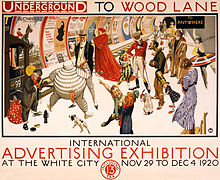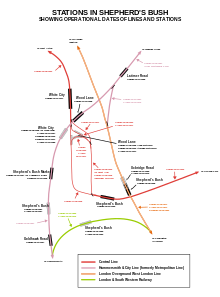White City is a district of London, England, in the northern part of Shepherd's Bush in the London Borough of Hammersmith and Fulham, 5 miles (8 km) west-northwest of Charing Cross. White City is home to Television Centre, White City Place, Westfield London and Queens Park Rangers football club's ground Loftus Road.

Shepherd's Bush is a district of West London, England, within the London Borough of Hammersmith and Fulham 4.9 miles (7.9 km) west of Charing Cross, and identified as a major metropolitan centre in the London Plan.

Shepherd's Bush is an area of west London, England, which has been served by a number of London Underground and commuter rail stations over the past 150 years, many of which have had similar names. The names Shepherd's Bush, Wood Lane and White City have each been used by several separate stations around the Shepherd's Bush district, following a number of station renamings and closures.
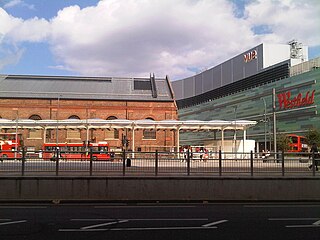
Wood Lane is a street in London. It runs north from Shepherd's Bush, under the Westway (A40) past Wormwood Scrubs where it meets Scrubs Lane. The road is wholly in the London Borough of Hammersmith and Fulham. It is probably best known as the former home of the BBC Television Centre, also BBC White City and formerly BBC Woodlands the offices of BBC Worldwide.
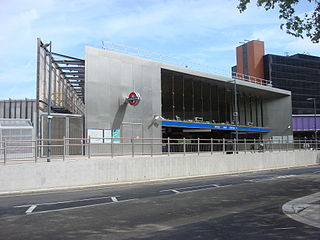
Wood Lane is a London Underground station in the White City area of west London, United Kingdom. It is on the Circle and Hammersmith & City lines, between Latimer Road and Shepherd's Bush Market stations, in Travelcard Zone 2.

White City is a London Underground station on Wood Lane in White City, west London, England, on the Central line between Shepherds Bush and East Acton stations in Travelcard Zone 2. The station is in a deep brick-sided cutting – and is designed in a similar way to Harrow-on-the-Hill station.

Wood Lane is a former station on the London Underground located in Shepherd's Bush, west London. It was latterly served by the Central line and from 1908 to 1920 was the western terminus of the Central line's precursor, the Central London Railway (CLR).
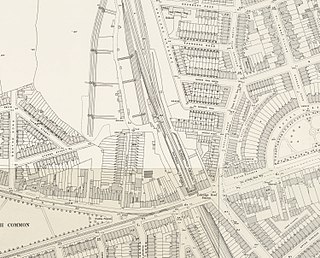
Uxbridge Road was a railway station on the West London Railway from 1869 to 1940. It was initially served by London & North Western Railway and the Great Western Railway. In 1905 the line became a branch of the Metropolitan Railway, and later London Underground's Metropolitan line. Uxbridge Road station closed on 21 October 1940 during World War II, when the West London Line was put out of service during the Blitz.
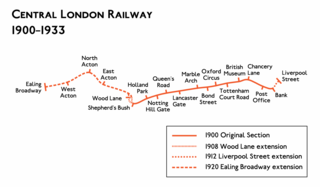
The Central London Railway (CLR), also known as the Twopenny Tube, was a deep-level, underground "tube" railway that opened in London in 1900. The CLR's tunnels and stations form the central section of the London Underground's Central line.
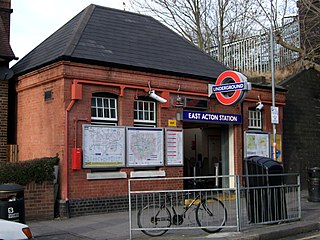
East Acton is a London Underground station in East Acton in London Borough of Hammersmith and Fulham. The station is on the Central line, between White City and North Acton stations, and in Travelcard Zone 2. Wormwood Scrubs, Queen Charlotte's and Chelsea Hospital, Hammersmith Hospital, Wormwood Scrubs prison and Imperial College Hammersmith branch are accessible from the station.

Shepherd's Bush is a London Underground station in the district of Shepherd's Bush in the London Borough of Hammersmith and Fulham. The station is on the Central line, between White City and Holland Park stations, and it lies in Travelcard Zone 2.

Shepherd's Bush Market is a London Underground station in the district of Shepherd's Bush in west London, England. It is on the Circle and Hammersmith & City Lines, between Goldhawk Road and Wood Lane stations, and it is in Travelcard Zone 2. Shepherd's Bush Market, from which the station takes its name, is an open-air market which runs parallel to the railway line.

Hammersmith was a railway station on the London and South Western Railway (LSWR), located on Grove Road in Hammersmith, west London. It was opened in 1869 and closed in 1916.

Westfield London is a large shopping centre in White City, west London, England, developed by the Westfield Group at a cost of £1.6bn, on a brownfield site formerly the home of the 1908 Franco-British Exhibition. The site is bounded by the West Cross Route (A3220), the Westway (A40) and Wood Lane (A219). It opened on 30 October 2008 and became the largest covered shopping development in the capital; originally a retail floor area of 1,600,000 sq ft (150,000 m2), further investment and expansion led to it becoming the largest shopping centre in Europe by March 2018, an area of 2,600,000 sq ft (240,000 m2).
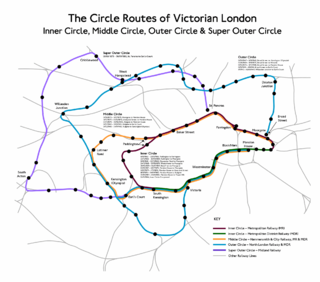
The Middle Circle was a Great Western Railway service in London that operated from 1872 to 1905. The route was from the District Railway station at Mansion House to Earl's Court, then via the West London Railway to Latimer Road on to the Hammersmith & City Railway and then via the Metropolitan Railway to the City of London. Although not a complete circuit, it was one of several 'circle' routes around London that opened at the same time, such as the 'inner circle' that is today's Circle line. Trains would run once every 30 minutes. In 1900 the service was cut back to run from Earl's Court to Aldgate, and ended in 1905.
The transport system now known as the London Underground began in 1863 with the Metropolitan Railway, the world's first underground railway. Over the next forty years, the early sub-surface lines reached out from the urban centre of the capital into the surrounding rural margins, leading to the development of new commuter suburbs. At the turn of the nineteenth century, new technology—including electric locomotives and improvements to the tunnelling shield—enabled new companies to construct a series of "tube" lines deeper underground. Initially rivals, the tube railway companies began to co-operate in advertising and through shared branding, eventually consolidating under the single ownership of the Underground Electric Railways Company of London (UERL), with lines stretching across London.
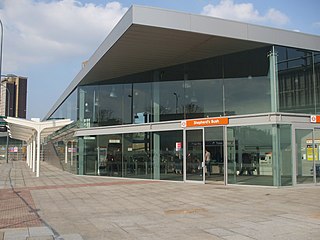
Shepherd's Bush station is a railway station located in the district of Shepherd's Bush in Greater London, England, UK. It opened on 29 September 2008 on the West London line and is served by London Overground and Southern rail services. It lies within Travelcard Zone 2.
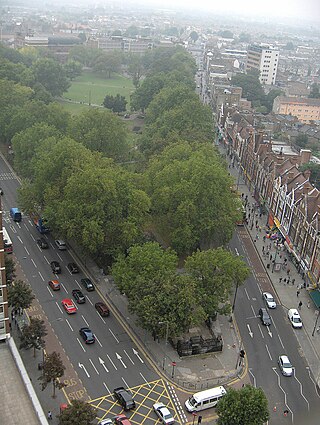
Shepherd's Bush is a neighbourhood in the London Borough of Hammersmith and Fulham centred on Shepherd's Bush Green. Originally a pasture for shepherds on their way to Smithfield market, it was largely developed in the late nineteenth and early twentieth centuries. In 1844 the West London Railway officially opened, followed in 1864 by the Metropolitan Railway who built the original Shepherd's Bush station, opening up the area to residential development. Businesses soon followed, and in 1903 the west side of Shepherd's Bush Green became the home of the Shepherd's Bush Empire, a music hall whose early performers included Charlie Chaplin.
White City Depot is one of three traction maintenance depots on the Central line of the London Underground. It is between Shepherd's Bush and White City tube stations. A depot on the site first opened in 1900 by the Central London Railway when the line first went into operation. A new underground depot opened in 2007, as part of the Westfield London shopping centre development. This makes it one of only two depots on the London Underground to be completely underground, the other being Waterloo Underground Depot on the Waterloo and City line.
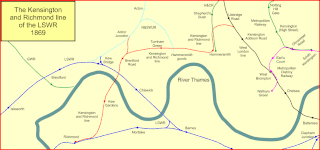
The Kensington and Richmond line was a railway in West London, England. It was built by the London and South Western Railway, which already had a main line to Richmond from London. The Kensington line was chiefly a defensive measure to limit the incursion of rival railways into LSWR territory. It ran from Kensington on the West London Railway, by way of Hammersmith, Turnham Green, Gunnersbury and Kew; it opened in 1869. It had a separate station at Richmond, in keeping with the LSWR intention of preventing competitors from easily obtaining running powers to go further into the LSWR area.

